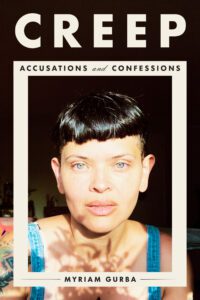On the night that I escaped from my abuser, a five-letter word broke his spell, helping to set me free. My abuser had stalked me to the safehouse where a queer couple was hiding me, and I could hear him pleading to be let inside. Before this confrontation, no one had defended me. Now, friends were about to unmask my abuser. “You’re a fucking creep!” one shouted at him. “Get out of here!” On that night, language illuminated the truth, and this spirit of announcement guides the pieces that make up CREEP: Accusations and Confessions.
The book’s first ten essays provide scaffolding for the final piece, a title essay that serves as a capstone account of my survival. The ever-present threat of femicide, which refers to the murder of a girl or woman motivated by misogyny, casts a long shadow across CREEP. Victims of this form of gender-based violence haunt its every page, and the histories of some of these women, like Joan Vollmer, who was slain by her common-law husband, the writer William S. Burroughs, might be familiar to some readers. Others, like Sophia Castro Torres, will likely be new to many.

While gender-based violence is one of the collection’s primary themes, creep is a gender-neutral category, and several essays take aim at non-male creeps and creepy institutions. In “Locas,” an essay that traces Latina criminalization, I explore the shitty impact that the US criminal legal system imposes on survivors of sexual violence. I also dissect the work and legacies of creepy female writers, like Joan Didion. In “The White Onion,” I survey, parse, and analyze the racism that taints Didion’s oeuvre, a body of work hailed as quintessentially Californian. Through an evaluation of her fiction and non-fiction, I show that this white “pioneer” descendant couldn’t have created her canonical vision of the Golden State without Mexican and Mexican American labor. I am, however, not one to let Mexicans off the hook. By critiquing the machismo of my own grandfather Ricardo Serrano Ríos, a Mexican poet, publicist, and bibliophile, I hold a mirror up to us, too.
The following are ten books that shaped the collection.
***
A Biography of Frida Kahlo by Hayden Herrera
When I was a kid, I found this book on our living room bookshelf and I’d spend hours staring at its glossy reproductions of the artist’s paintings. In Creep, I reference two of Kahlo’s most violent works, “The Suicide of Dorothy Hale” and “A Few Small Nips.”

Barbie Forever: Her Inspiration, History and Legacy by Robin Gerber
Any self-respecting book about girlhood in the US should feature Barbies. Creep opens with a scene that involves girls realistically playing with, and therefore killing, this iconic toy.

Pedro Páramo by Juan Rulfo
Some literary historians argue that the novel Pedro Páramo established the genre of magic realism. Its author and my grandfather had an odd relationship. One could call them…frenemies.

Trejo: My Life of Crime, Redemption and Hollywood by Danny Trejo
Mexican American actor Danny Trejo makes a brief appearance in my essay on Didion. He and I go to the same eye doctor.

“The Invisible Weight of Whiteness: The Racial Grammar of Everyday Life in Contemporary America” by Eduardo Bonilla Silva
In this paper, sociologist Bonilla Silva offers a theory of racial grammar that “normalizes the standards of white supremacy as the standards for all sort of social events and transactions.” I use this theory in my analysis of Didion’s work.

Ringside Seat to a Revolution: An Underground Cultural History of El Paso and Juarez, 1893-1923 by David Dorado Romo
In my essay “Itchy,” I detail the bigotry I witnessed working in California’s public schools. Dorado Romo’s history of El Paso, particularly as it relates to the racialized history of human hygiene and fascism, was an invaluable resource.

Crazy Cock by Henry Miller
This was the first Miller novel that I read. I stole it from the city library and kept it under my bed, thrilled that one of its lesbian characters was my namesake.

Practically Joking by Moira Marsh
I’m fascinated by the intersection of humor and horror and in the essay “Slimed,” I draw parallels between sexual violence and pranks. I relied on Marsh’s typologies when inventorying types of practical jokes.

Post-Traumatic by Chantal V. Johnson
Johnson’s novel is one of the few on sexual violence that doesn’t shy away from using gruesome humor. I cite her work in the essay “Slimed.”

Coercive Control: How Men Entrap Women in Personal Life by Evan Stark
This book is a must-read for anyone seeking to understand the most widespread form of gender-based violence that women endure in “romantic” relationships. Because of this book, I was able to acknowledge that I had been trapped.





